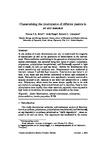Characterising the deterioration of different plastics in air and seawater
| dc.contributor.author | Biber, NFA | |
| dc.contributor.author | Foggo, Andrew | |
| dc.contributor.author | Thompson, Richard | |
| dc.date.accessioned | 2019-03-19T08:20:44Z | |
| dc.date.issued | 2019-04 | |
| dc.identifier.issn | 0025-326X | |
| dc.identifier.issn | 1879-3363 | |
| dc.identifier.uri | http://hdl.handle.net/10026.1/13494 | |
| dc.description.abstract |
In situ studies of plastic deterioration can help us understand the longevity of macroplastic as well as the generation of microplastics in the environment. Photo-oxidation contributing to the generation of microplastics in the marine environment was explored using four types of plastic (polyethene, polystyrene, poly(ethylene terephthalate) and Biothene® exposed in light and in shade, in both air and sea water. Metrics for deterioration were tensile extensibility and oxidation rate. Measurements were conducted at intervals between 7 and 600 days' exposure. Deterioration was faster in air than in sea water and was further accelerated in direct light compared to shade. Extensibility and oxidation were significantly inversely correlated in samples exposed in air. Samples in sea water lost extensibility at a slower rate. Polystyrene, which enters the waste stream rapidly due to its wide application in packaging, deteriorated fastest and is, therefore, likely to form microplastics more rapidly than other materials, especially when exposed to high levels of irradiation, for example when stranded on the shore. | |
| dc.format.extent | 595-602 | |
| dc.format.medium | Print-Electronic | |
| dc.language | en | |
| dc.language.iso | en | |
| dc.publisher | Elsevier | |
| dc.subject | Plastic deterioration | |
| dc.subject | Natural environment | |
| dc.subject | Polystyrene | |
| dc.subject | Photo-oxidation | |
| dc.subject | Tensile properties | |
| dc.subject | FTIR | |
| dc.title | Characterising the deterioration of different plastics in air and seawater | |
| dc.type | journal-article | |
| dc.type | Journal Article | |
| plymouth.author-url | https://www.webofscience.com/api/gateway?GWVersion=2&SrcApp=PARTNER_APP&SrcAuth=LinksAMR&KeyUT=WOS:000465509700066&DestLinkType=FullRecord&DestApp=ALL_WOS&UsrCustomerID=11bb513d99f797142bcfeffcc58ea008 | |
| plymouth.volume | 141 | |
| plymouth.publication-status | Published | |
| plymouth.journal | Marine Pollution Bulletin | |
| dc.identifier.doi | 10.1016/j.marpolbul.2019.02.068 | |
| plymouth.organisational-group | /Plymouth | |
| plymouth.organisational-group | /Plymouth/Faculty of Science and Engineering | |
| plymouth.organisational-group | /Plymouth/Faculty of Science and Engineering/School of Biological and Marine Sciences | |
| plymouth.organisational-group | /Plymouth/REF 2021 Researchers by UoA | |
| plymouth.organisational-group | /Plymouth/REF 2021 Researchers by UoA/UoA07 Earth Systems and Environmental Sciences | |
| plymouth.organisational-group | /Plymouth/Research Groups | |
| plymouth.organisational-group | /Plymouth/Research Groups/Marine Institute | |
| plymouth.organisational-group | /Plymouth/Users by role | |
| plymouth.organisational-group | /Plymouth/Users by role/Academics | |
| plymouth.organisational-group | /Plymouth/Users by role/Researchers in ResearchFish submission | |
| dc.publisher.place | England | |
| dcterms.dateAccepted | 2019-02-27 | |
| dc.rights.embargodate | 2020-3-12 | |
| dc.identifier.eissn | 1879-3363 | |
| dc.rights.embargoperiod | Not known | |
| rioxxterms.versionofrecord | 10.1016/j.marpolbul.2019.02.068 | |
| rioxxterms.licenseref.uri | http://www.rioxx.net/licenses/all-rights-reserved | |
| rioxxterms.licenseref.startdate | 2019-04 | |
| rioxxterms.type | Journal Article/Review |


